|

Sinhala and Tamil New Year:
Customs and traditions
|
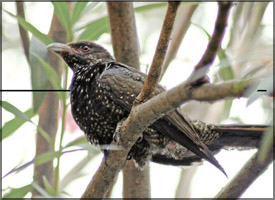
Cuckoo or Koel bird |
It is the nature that gives the green light to Sinhala and Hindu New
Year with the two-note call of the cuckoo, or Koha commonly known among
the Sri Lankan community. The New Year is full of traditions and customs
with legends, both Sinhala and Tamil, embedded within.
Professor Sunanda Mahendra takes a glimpse on a few legends. The
Sinhala and Tamil New year falls in April due to many reasons. The
Sinhala term Bak for April is a shortened form of Bhagya which means
wealth in English. Sri Lanka has an agricultural background that enables
a farmer work almost the whole year.
This New Year period is the time for the farmer to relax and enjoy
his harvest. Bak hence denotes the harvest a farmer brings home with
happiness cast on his face.
Auspicious times play a major role during the season. Buddhism does
not believe in good and bad times, but sociologically speaking,
auspicious times stand for punctuality, signifying its applicability to
modern time management concept.
The Sinhala New Year is, simply put, working according to a scheduled
time-table. Gazing at the old moon and ritual bathing for the passing
year initiates punctuality. Observing the new moon for the incoming year
signifies the dawn of the New Year. The custom is believed to bring
prosperity.
|

Preparation of meals |
|
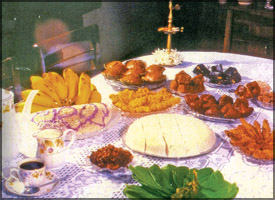
A typical Avurudu table |
|

Pancha Keliya |
The Sinhala New Year traditions stem from various legends. One fine
example is respecting the elders with a sheaf of betel.
The herb is believed to be free from poison and the belief goes as
far back to the legend of Sakra, chief of the gods, who had put down the
brush after drawing a pious hare?s picture on the moon. The brush
dropped on the lap of the king of snakes.
A betel creeper has sprouted out from the place, and a man had it
planted in his garden. The herb which is planted in the human soil -
bhumiye lat heyin in Sinhala and as born out of earth in English - came
to be known as bulat. The betal sheaf has the power of turning your
enemies into friends when offered during the New Year period.
Transactions, or Ganu denu, revolve round natural functions like
building new friendships with fellow beings and flora and fauna. A young
person will give some amount to an elder to be returned with a higher
amount.
The housewife drops a coin to well, to maintain her relations with
the most helpful companion in the kitchen.
Significant ritual
Both customs of respecting the elders and transactions motivate and
remind the young generation of the value of the elder generation. The
Sinhala Avurudu turns not only enemies into friends, but it also links
the distant parent-children relationships as well.
The next most significant ritual is the ceremony of anointing oil on
head hisatel gama mangalyaya.
This is carried out in the villages; the temple?s chief incumbent
makes use of the opportunity to meet the villagers and anoint the herbal
oil prepared by a village physician with a medicinal plant. Village head
master and householder of an ancestral house anoint oil on the well
wishers and allow them for a meal with them. This is performed with a
fine four line verse which goes as follows:
Kalu kaputa
suduvenaturu
Ehela kanuava
liyalanaturu
Gebmbidtita tana enaturu
Siyayata desiyayak
- ayuboveva ayuboveva!
(Until the black crow becomes white, until the Ehela post sprouts out
tendrils and until the baby she-frog grows out a breast,
|
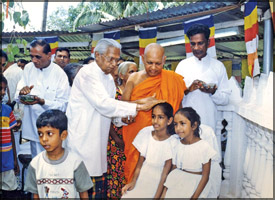
Anointing oil |
|
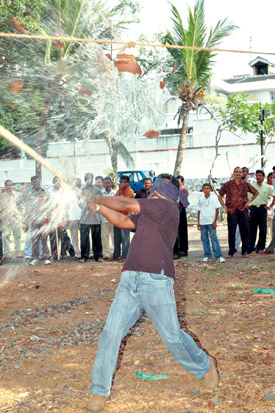
Kana Mutti |
may you live so
long from hundred to two hundred years span of life)
This blessing verse may sound humorous, but it has its fresh flavour
denoting longevity. It is also believed that the New Year is the period
of folk games and rituals.
Many indoor and outdoor games are interlinked to the ritual of the
Pattini cult. The Pattini ritual is remembered when an attempt is made
to test the chastity of the woman called Pattini.
Once her husband was killed by a lecherous king to possess her. But
faithful Pattini or Pattini Devi did not succumb to his needs and
desires, but performed an act of truth (satya kriyava) instead and the
chief of god, Sakra, saw that she is one of the most virtuous woman one
could find on earth. Followed by this thought and the test, Sakra the
god of gods, gives life to her husband Palanga.
The story is found in the folk verse titled Pattini Hella and Palanga
Hella. When people come to know that the good wife and the husband are
brought to life they make merriment which is the standpoint in the folk
games inherited. The husband and wife lead a better life avoiding the
evil eye.
The game Ankeliya is one such example for Pattini inheritance. The
two teams: upper team, udu pila, and lower team, yati pila, represent
the husband and wife respectively. Whichever wins go round the village
hailing the victory; this is known as jalli demima in Sinhala.
Culture
The folk games connected with the New Year are mostly symbolic of the
fertility cult where the expectation of a new era is the sole objective.
Pattini culture is brought out in meal preparation as well. One of the
main dishes for the New Year meal is Hath Maluwa comprised of 7 types of
vegetables: Ash plantain, gold melon buds, cashew, elabatu, jack seeds,
lone fingers, and water melon.
These types are believed to be brought from 7 directions to wipe off
any ill effect on the New Year. This curry essentially contains no
animal food.
In this manner the ritual and the cult connected with the Pattini
legend has given a spiritual affinity to many ceremonial activities of
the Sinhala and Hindu New Year.
|
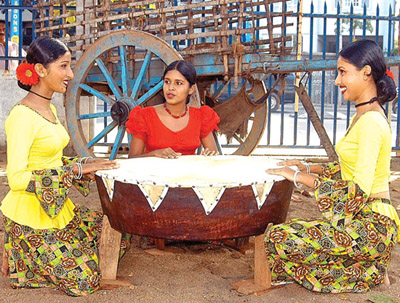
An assembly of gods in days of yore was in high spirits over
the New Year festival. It was yet to be discovered by one
divine member that only voices filled the festival spirit,
but no instruments! The rest of the divine community slowly
felt the need of an instrument. One angel created a small
circular instrument, and when the divine members struck on
it, it gave a sound! The instrument was small and when it
was struck continuously, it grew larger. And thus the Rabana,
or Hand Drum came into existence. |
|

